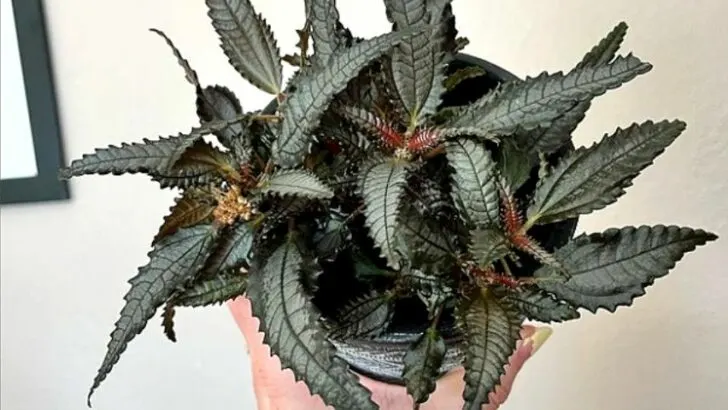This exotic plant caught my attention! It is called Pilea Dark Mystery, and you must admit, even the name is intriguing.
Pilea Dark Mystery is an easy-to-grow houseplant with stunning dark green leaves with a chocolate brown tinge and silvery stripes up the center.
The leaves look like spooky lizard tails contrasted by clusters of small pink flowers just above the foliage. A mystery indeed!
The plant will thrive in a pot near a window that gets bright light. If you are ambitious and are thinking of starting an indoor terrarium, this is a great choice to get you going.
Table of Contents
Pilea Dark Mystery Plant Care
Pilea Dark Mystery does best in all-purpose, well-draining soil that has added organic matter and perlite. It needs 6 hours of bright indirect sunlight per day. Water well when the top 1 inch of soil is dry. Ideal day temperatures are 62°F to 85°F (16°C to 29°C). It is not suited for colder climates.

Soil
Pilea Dark Mystery does best in well-draining, all-purpose potting soil. You can add organic matter and coco coir to enrich the soil. To increase drainage, add in a handful of perlite or vermiculite. It also thrives in a purchased soil formulated for African Violets.
Plant your Pilea Dark Mystery into all-purpose potting soil. It loves rich organic matter, so you can add in decomposing compost or coco coir.
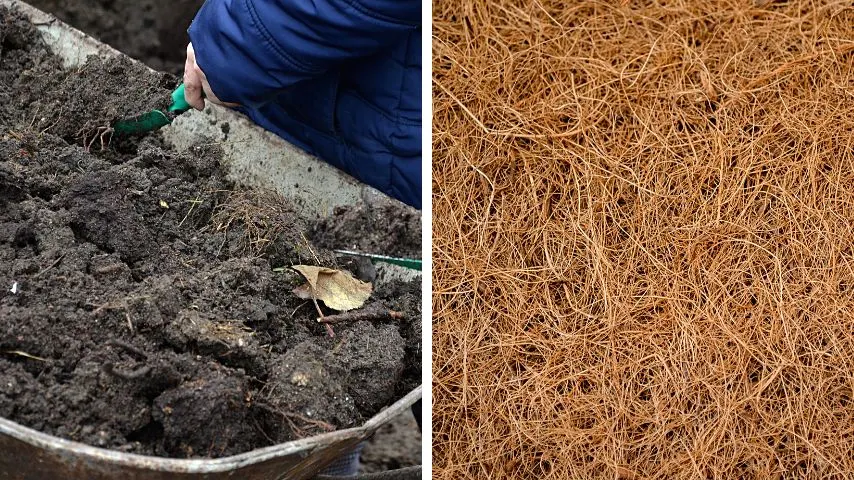
Pilea is native to moist regions, both tropical and subtropical. To make the perfect soil to match these regions, add a 2-inch (5cm) layer of mulch to the base of your pot to help retain moisture.
This plant must have well-draining soil. To enhance drainage, I like to add a handful of vermiculite or perlite to the soil.
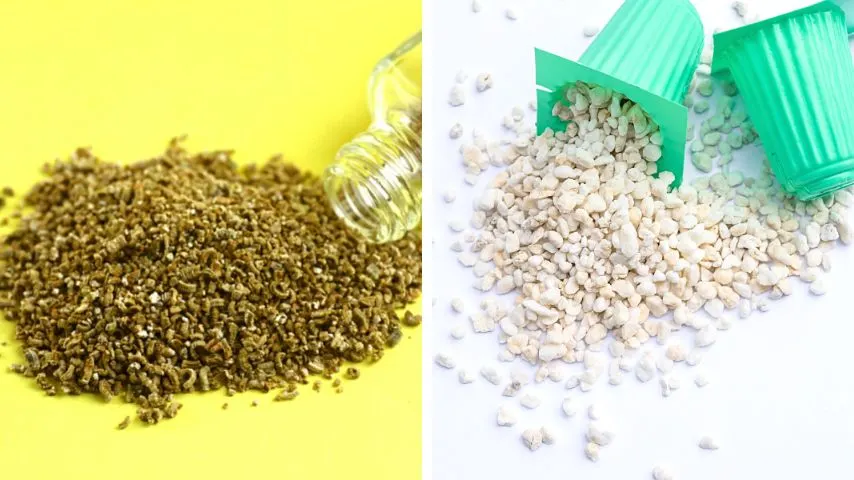
Water should not accumulate at the base of your pot, but should run out freely.
When it comes to the pH balance of the soil, Pilea Dark Mystery is happy in acidic to neutral soil.
A small home testing PH kit will help you check the levels. Look for a reading of between 6.0 to 7.5.
Light
Pilea Dark Mystery enjoys bright light. It should get bright light for up to 8 hours per day. Do not place it in direct sunlight as the leaves will be scorched. Place your plant within 3 feet (1m) of a window for the best results. South-facing rooms offer the ideal bright sunny conditions.
Pilea Dark Mystery loves bright light — lots of it! A south-facing room is perfect as for most of the day it receives sunlight.
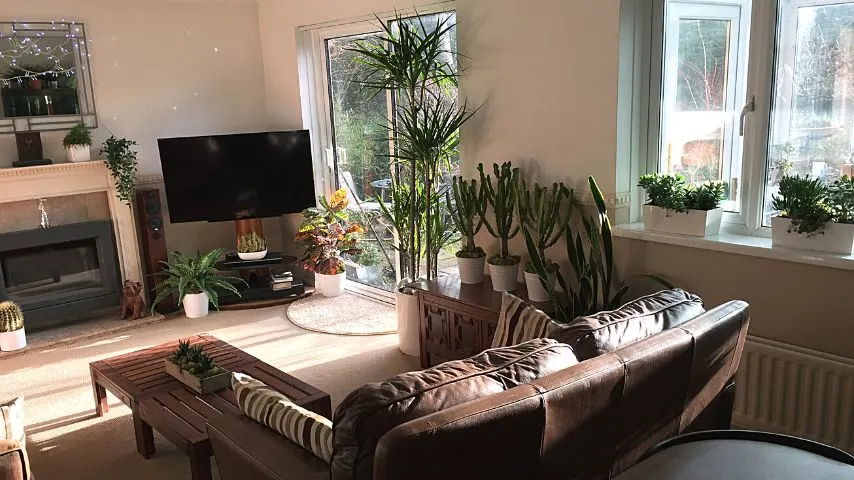
But, ensure that your plant does not stand in direct sunlight. This will scorch the leaves and can fatally damage your plant.
Choose a spot that is within 3 feet (1m) of a window. If the sun reaches the plant, you can use a sun filter curtain to keep off the direct sun rays but still allow bright light to enter.
North-facing rooms will offer too little light. Without bright light, your Dark Mystery will start to drop its leaves.
Try to find a more suitable spot for it as soon as possible.
Dark Mystery grows towards the light. To prevent excessive growth on one side, rotate your pot every few weeks.
Watering
Your Pilea Dark Mystery requires fairly high water amounts. Don’t allow the soil to dry out before you water it. Water when the soil’s top 1 inch (2.5cm) dries out. Plan to give your plant just under 1 cup of water every 7 to 9 days. Underwatering causes the leaves to droop.
Pilea Dark Mystery does need attention when it comes to water. This plant has a high water requirement.
Don’t wait for the soil to dry out first before you water the Pilea Dark Mystery.
Test the top 1 inch (2.5cm) of the soil in your pot. If it is dry, water it.
If you enjoy having a routine, plan to give your plant just under a cup of water every nine days, which is already ideal for a 5-inch (13cm) pot.
Adjust the amount of water if your pot is larger.
Adding perlite to your soil will help retain moisture without clogging up like clay soils. Perlite has a coarse texture that also improves soil aeration.
Temperature
Pilea Dark Mystery thrives best in indoor temperatures that range from 62°F to 85°F (16°C to 29°C) during the day and 50°F to 65°F (10°C to 18°C) at night. It won’t do well in colder temperatures. It does not enjoy draughts from air conditioners. It is most suited for USDA hardiness zones 10 and 11.
This plant grows naturally in warmer regions and won’t do well in cold climates.
For indoor day temperatures, a range of 62°F to 85°F (16°C to 29°C) is best. Night temperatures should not fall below 50°F. (10°C).
Like many house plants, Pilea Dark Mystery is not tolerant of cold draughts. Don’t position your container in front of an air conditioner or in a draughty spot.
Although it enjoys warmer temperatures, it does not do well in direct sunlight.
Do not try to warm up your plant by placing it in the sun – the leaves will scorch and suffer damage.
Humidity
Pilea Dark Mystery enjoys average to slightly humid conditions. Your home humidity of 40% to 60% is adequate provided that you water regularly. Do not let your soil dry out. Occasional mist spraying and pebble trays can increase humidity in your indoor garden.
Conditions that are average or slightly higher are ideal for Pilea Dark Mystery. An average home has a humidity of 40% to 60%.
If your climate is very dry, installing a small humidifier will help to add moisture into the air.
Occasional mist spraying and pebble trays can increase the humidity in your indoor garden.
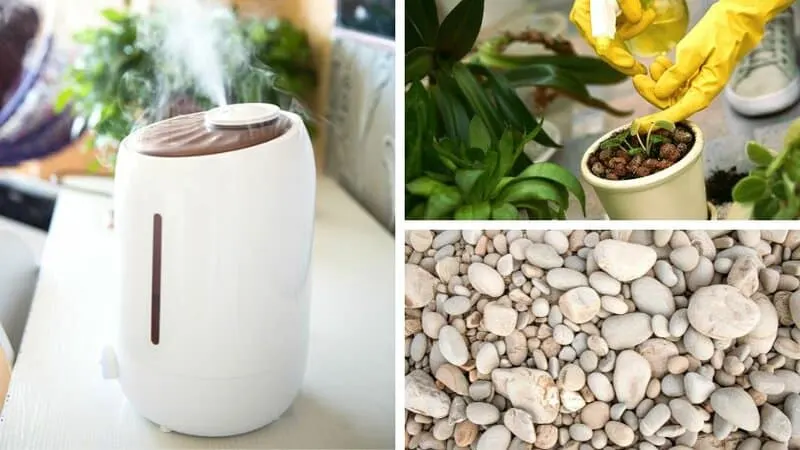
Make sure that the soil is kept moist and it doesn’t dry out between waterings. When the soil’s top 1 inch (2,5cm) is dry, water it already.
Fertilizer
Rich, all-purpose potting soil with added organic matter will provide enough nutrients for Pilea Dark Mystery. Fertilize using a liquid houseplant fertilizer that’s diluted to half of its strength once in spring and in summer as well.
If you have started with rich potting soil, your plant will grow happily and won’t need much fertilizing. It does grow fast and can be repotted when it doubles in size.
By repotting, you will once again replenish the nutrients in the soil.
If you enjoy fertilizing your plants, choose a balanced all-purpose liquid houseplant fertilizer. Dilute to half strength.
Water your plant, allow the water to drain out, and add the fertilizer solution.
Fertilize once in spring and once in summer. You should not fertilize in winter as your plant needs to rest.
Growth
Pilea Dark Mystery offers dark green leaves with a brown tinge and silver streaks. Small clusters of pink flowers bloom above its foliage. It reaches a height of 10 inches (25cm) with a spread of 10 inches (25cm). It grows as a low mounding variety that can get straggly when the lower leaves fall.
The mysterious Pilea will create a focal point in your indoor garden. The leaves look a little like lizard’s tails and have a dark green color tinged with chocolate brown.
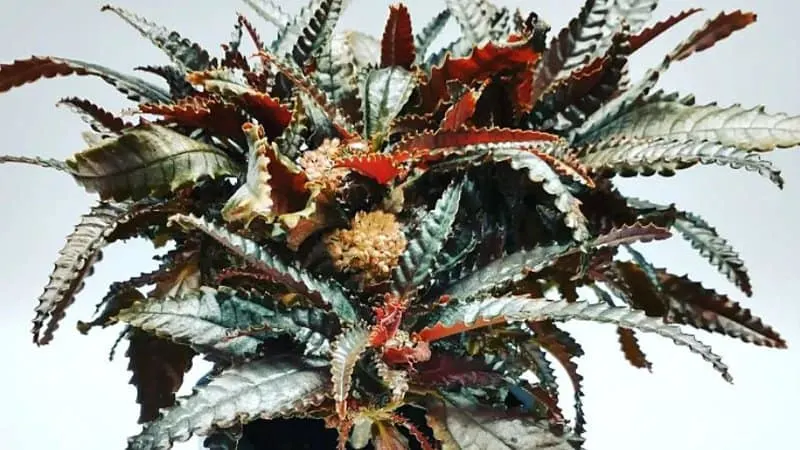
Silver streaks add an interesting contrast. In spring, small clusters of pretty pink flowers bloom above the foliage.
New growth shows a warm rose color before darkening.
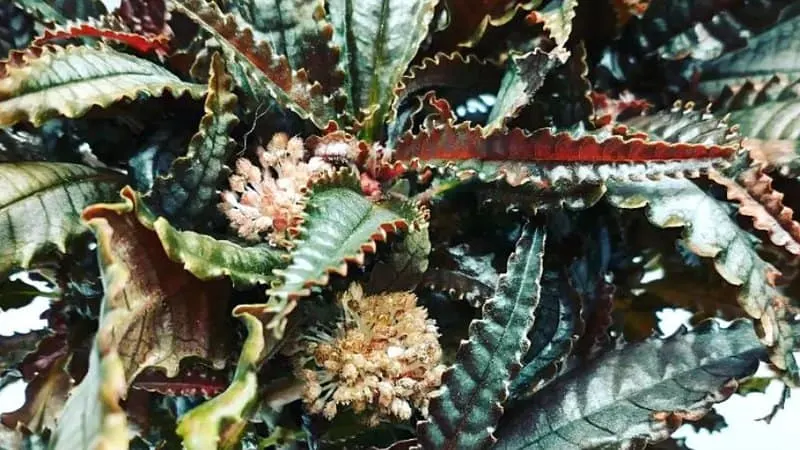
The plant does best in a small pot and has a low mounding habit. It can grow to heights of 10 inches (25cm) with a spread of 10 inches (25cm).
This plant loves sunlight and will grow towards the light. Ensure that you rotate your pot every few weeks to prevent uneven growth on one side.
Growth is fairly fast, and you may have to repot once a year when it has doubled in size.
Potting
Pilea Dark Mystery does best in small pots. Start your plant in a pot that is 4 to 5 inches (10cm to 13cm) wide. Plant into rich, all-purpose potting soil and add organic matter, peat moss, and perlite. Water well and place in a spot with lots of bright light but not direct sun.
Choose a 4-inch to 5-inch (10cm to 13cm) pot for your Pilea Dark Mystery. It does best in a smaller pot where the roots are restricted.
Use an all-purpose potting soil. You can enrich it by adding organic matter, coco coir, and a handful of vermiculite or perlite.
This plant loves rich, moist soil. Place your plant into the center of the pot and pack the soil lightly around it.
Water well and place it in a bright spot with lots of light. Avoid direct sunshine.
Fertilizing is not necessary if your soil contains loads of organic matter.
Plan to repot once a year when your plant has doubled in size.
Pruning
Pilea Dark Mystery tends to get scraggly over time. To keep your plant compact and neat, you can trim off the tips of new growth. Remove the lower leaves when you see that they start drooping. Trim off any damaged or diseased stems.
Heavy pruning is not necessary but you will need to do a small amount of neatening up from time to time. Pilea Dark Mystery can get leggy and scraggly.
To maintain a low bushy shape, pinch off the tips of new growth.
As the plant gets older, the lower leaves droop and fall off. To keep it looking neat, gently remove these leaves when you see them starting to droop.
Pilea Dark Mystery In-depth Propagation Guide
Propagation is easy to do using cuttings from an existing plant. Follow these steps!
Propagate Pilea Dark Mystery from Cuttings
- The best time to do your propagating is in spring
- Sterilize a small sharp cutter
- Cut off small pieces of stem, around 6 to 8 inches (15cm to 20cm) long
- Choose cuttings with a few leaves on them
- Remove its leaves from the lower end of the stem
- Place the stems into a glass of clean water
- Leave the glass in a warm place
- Gently add fresh water when required
- Roots should appear within 3 to 4 weeks
- Prepare your new pots with all-purpose potting soil, organic matter, and perlite
- Carefully plant the cuttings into the new pots without breaking the roots off
- Provide support for the stems if necessary
- Place the pots in a spot where the temperature is above 65°F (18°C) and has bright filtered light
View this post on Instagram
Common Problems with Pilea Dark Mystery
1. Pest Control
Pilea Dark Mystery is fairly pest-resistant. Pests that may infest your plant are mealybugs and spider mites.
Using Neem oil or insecticidal soaps can also help to remove them.
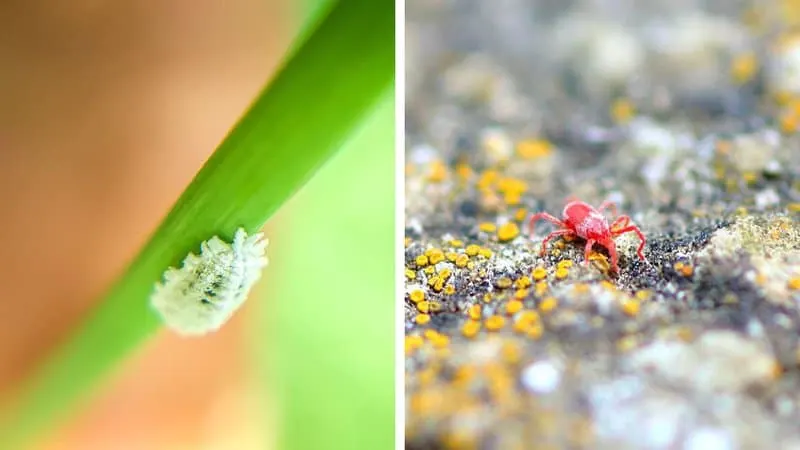
Dark Mystery can also be affected by botrytis, which commonly attacks in the colder months when there is less bright light.
Prune off the infected plant parts. Sterilize your pruners for the disease not to spread further.
Burn or bury the infected plant material.
2. Leaves Drop Off
This is usually caused by too little light. Your plant must have at least 6 hours of indirect yet bright light exposure daily.
A room that faces south is the best position.
3. Leaves have Brown Spots
This can occur if the plant stands in direct sunlight. The sun will scorch the leaves.
Move it to a spot that has indirect but bright light.
4. Plant becomes very Leggy
Leggy plants are caused by too little light. You’ll also notice that the Pilea Dark Mystery’s leaves turn a darker green.
Move the Pilea Dark Mystery into a spot receiving bright yet indirect sunlight.
Tips to Grow Pilea Dark Mystery
- Choose a small pot around 4 to 5 inches (10cm to 13cm) in size
- Plant into an all-purpose soil mix that is well-draining
- Add in peat or vermiculite
- Water when the soil’s top 1 inch (2.5cm) when it dries
- Keep in a bright spot with 6 to 8 hours of indirect sunlight
- If your humidity is low, consider a humidifier or pebble bath
- Fertilize only once in spring and once in summer
- Trim to keep the shape neat
Toxicity
Pilea Dark Mystery is non-toxic to cats and dogs as well as humans. Pileas are pet-friendly plants. You do not have to worry if animals chew on the plant leaves.
Frequently Asked Questions about Pilea Dark Mystery Plant Care
Can Pilea Dark Mystery grow in low light?
Pilea Dark Mystery requires bright yet indirect sunlight for most of the day. Its leaves will begin falling off if it receives too little light.
Is it easy to care for Pilea Dark Mystery plants?
Care is easy, and there is not a lot of maintenance for your Pilea Dark Mystery plants. Ensure that your plant has plenty of bright and indirect light received. Water when the plant’s top inch of the soil dries out. Turn your pot regularly to prevent uneven plant growth on either side.
Is Pilea Dark Mystery considered a toxic plant?
The Pilea Dark Mystery isn’t a toxic plant. You won’t have to worry if your home has pets and/or children as they’re perfectly safe for them.
Conclusion
If you are looking for an interesting plant with dark leaves, the Pilea Dark Mystery is a great choice.
It is easy for beginners to grow and makes a fabulous addition to any indoor garden.

Daniel has been a plant enthusiast for over 20 years. He owns hundreds of houseplants and prepares for the chili growing seasons yearly with great anticipation. His favorite plants are plant species in the Araceae family, such as Monstera, Philodendron, and Anthurium. He also loves gardening and is growing hot peppers, tomatoes, and many more vegetables.

